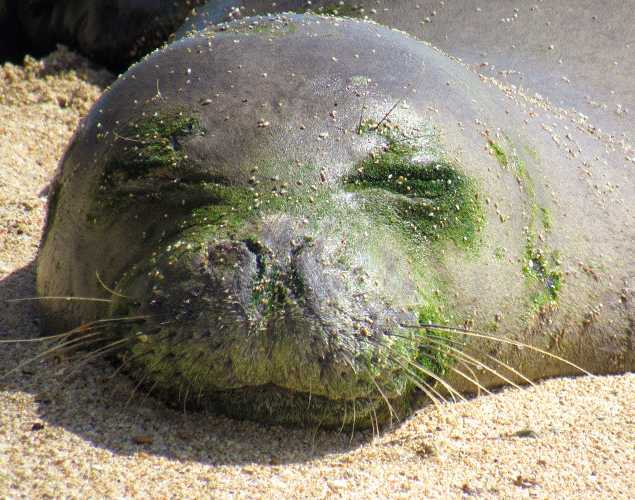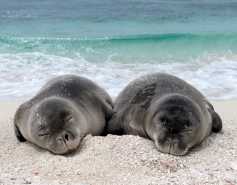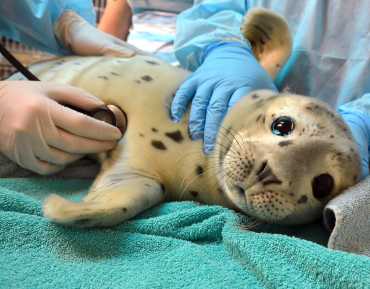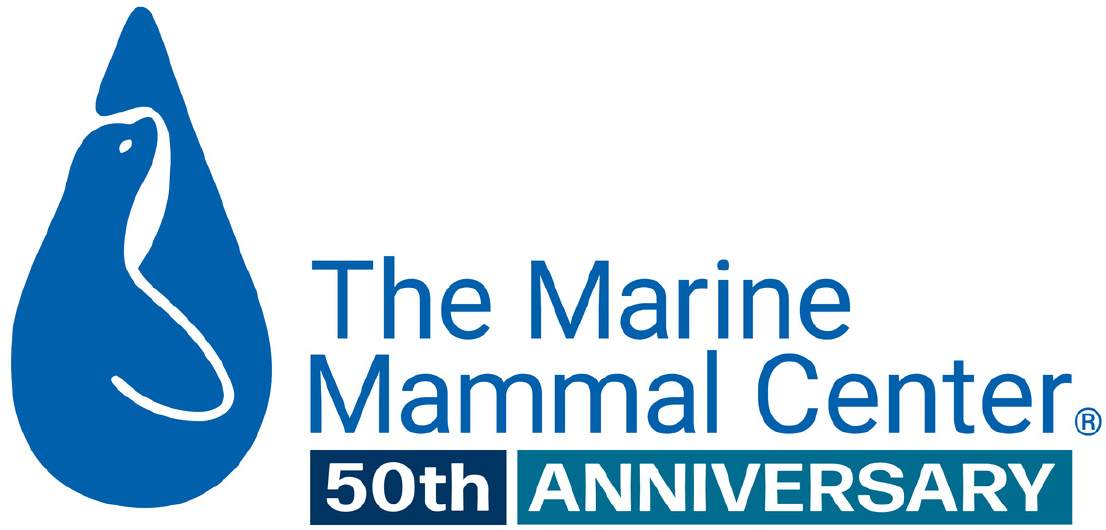
Endangered Hawaiian Monk Seal Battling Toxoplasmosis
- Species conservation
- Toxoplasmosis
Adult Hawaiian monk seal Pōhaku is suffering from a potentially lethal parasitic infection called toxoplasmosis, a leading cause of death in monk seals.
The Marine Mammal Center has admitted an adult female Hawaiian monk seal named Pōhaku to Ke Kai Ola, our hospital on the Big Island of Hawai‘i, for long-term care and treatment for toxoplasmosis, a parasitic infection known to be deadly to monk seals.
In late January, Pōhaku was spotted in the waters off the coast of Oahu logging, a behavior in which a monk seal inactively floats on the ocean’s surface for an extended period. This particular monk seal is known to have a history of logging in this area for about a day at a time. But when she appeared to be behaving lethargically two days in a row, experts became concerned.
Once responders were able to safely rescue Pōhaku, she was transported to NOAA’s Inouye Regional Center (IRC) on Oahu, where she underwent an examination guided by Dr. Michelle Barbieri, an alumni of the Center’s Teaching Hospital who now leads the Hawaiian Monk Seal Response Program at NOAA.
Upon admit to the IRC, Pōhaku was alert, responsive and appeared to have no obvious physical injuries. The veterinary team suspected that she may be suffering from gastrointestinal upset, so they gave her treatment for that as well as antibiotics and other supportive care.
But Pōhaku’s blood work revealed an extremely worrisome result: she was diagnosed with toxoplasmosis, a potentially deadly disease that can cause brain infection and muscle tremors. Toxoplasmosis is a leading cause of death in monk seals and also affects other marine mammals, such as southern sea otters, a threatened species.
For an animal of Pōhaku’s size (she initially weighed in at over 480 pounds!), treatment can be intense and challenging, requiring a long course of medication that can be taxing on the patient. Staff from our animal care team based in Kona, Hawai‘i, regularly supported Pōhaku’s treatment on Oahu before she was transported to Ke Kai Ola for long-term care.
As the only partner organization permitted by NOAA to treat and rehabilitate endangered Hawaiian monk seals, we’re proud to be able to support patients like Pōhaku at our state-of-the-art facility in Kona.
“As the only partner organization permitted by NOAA to treat and rehabilitate endangered Hawaiian monk seals, we’re proud to be able to support patients like Pōhaku at our state-of-the-art facility in Kona,” said Megan McGinnis, the Center’s Animal Care Program Manager at Ke Kai Ola.
You may remember that we currently have four other female Hawaiian monk seals in our care, who are housed together. However, Pōhaku will be in her own pen as she is currently weak, lethargic and in need of rest.
Pōhaku cannot transmit toxoplasmosis to the other patients because this infection is caused by a common parasitic protozoan called Toxoplasma gondii, which can only reproduce in a cat’s gut. Both domestic and wild cats shed the parasite’s oocysts, or egg-like structures, in their feces.
The oocysts are able to survive for months in extreme environmental conditions and therefore can contaminate the ocean food chain through disposal of cat litter in the toilet or from outdoor cats that live near natural water sources. Marine mammals like Hawaiian monk seals are then exposed to this parasite’s eggs by consuming contaminated prey or water.
Learn More About Hawaiian Monk Seal Conservation
{"image":"\/Animals\/Wild\/Hawaiian monk seal\/cropped-images\/HMS-wild-NOAA-4-832-3197-1474-1603733454.jpg","alt":"Two Hawaiian monk seals sleeping on the beach.","label":"Conservation","title":"Hawaiian Monk Seal Conservation","link_url":"\/science-conservation\/conservation\/hawaiian-monk-seal-conservation","type":"page"}

Along with ocean trash and sea level rise, toxoplasmosis is one of the main threats facing the endangered Hawaiian monk seal population, partly because the infection is so difficult to detect. Most monk seals with toxoplasmosis are found dead without warning; only two other seals have been rescued prior to death and both succumbed to the disease within 48 hours of rescue.
Pōhaku has survived longer than any other monk seal with toxoplasmosis but her prognosis is still guarded, and treatment will be decided on a day-by-day basis.
Because no vaccine is available for toxoplasmosis, preventative measures must be taken by people like you. It’s easy to help protect endangered Hawaiian monk seals like Pōhaku from toxoplasmosis—simply dispose of cat litter in the trash, keep your cats safe indoors and tell your community about how they too can prevent this disease from harming more marine mammals.
We are proud to partner with NOAA to support conservation efforts for the Hawaiian monk seal. NOAA researchers estimate the current monk seal population to be about 1,400 animals—about 30 percent of those monk seals are alive today directly due to conservation efforts led by NOAA and partners like us.
Yes, I want to save a life!

Yes, I want to save a life!
You’ll be giving sick and injured animals the best possible care at the Center’s state-of-the-art hospital. With your gift today, you are giving a patient a second chance at life in the wild.
See Our Latest News
{"image":"\/Animals\/Patients\/Hawaiian monk seals\/2025\/cropped-images\/d-ru28release-exam-at-ke-kai-ola111025photo-by-giancarlo-rulli-c-the-marine-mammal-center-noaa-permit-24359-0-0-1270-992-1764620886.jpg","alt":"","title":"Bird Flu Vaccine Trial Offers Hope for Protecting Hawaiian Monk Seals","link_url":"https:\/\/www.marinemammalcenter.org\/news\/bird-flu-vaccine-trial-may-offer-hope-for-protecting-hawaiian-monk-seals","label":"News Update","date":"2025-12-01 08:13:00"}

Bird Flu Vaccine Trial Offers Hope for Protecting Hawaiian Monk Seals
December 1, 2025
Read More{"image":"\/Animals\/Patients\/Hawaiian monk seals\/2021\/hms-pp08-by-sheila-latta-c-the-marine-mammal-center-noaa-permit-18786.jpg","alt":"Hawaiian monk seal","title":"The New York Times: Inside the Bird-Flu Vaccine Trial for Monk Seals","link_url":"https:\/\/www.marinemammalcenter.org\/news\/the-new-york-times-inside-the-bird-flu-vaccine-trial-for-monk-seals","label":"In the News","date":"2025-12-01 01:00:00"}

The New York Times: Inside the Bird-Flu Vaccine Trial for Monk Seals
December 1, 2025
Read More{"image":"\/Animals\/Wild\/Sea otter\/so-wild-morro-bayphoto-c-brian-simuro-20.jpeg","alt":"Sea otter and pup","title":"Watch a Sea Otter Pup Reunite With Its Mother","link_url":"https:\/\/www.marinemammalcenter.org\/news\/watch-sea-otter-pup-reunite-with-its-mother","label":"News Update","date":"2025-11-14 10:35:41"}

{"image":"\/Animals\/Wild\/Sea otter\/sea-otter-photo-c-brian-simuro.jpeg","alt":"Sea otter","title":"AP News: Baby sea otter is reunited with mother in central California after dramatic rescue","link_url":"https:\/\/www.marinemammalcenter.org\/news\/ap-news-baby-sea-otter-is-reunited-with-mother-in-central-california-after-dramatic-rescue","label":"In the News","date":"2025-11-14 09:46:34"}

AP News: Baby sea otter is reunited with mother in central California after dramatic rescue
November 14, 2025
Read Moretoxoplasmosis
Megan McGinnis
Hawaiian Monk Seal

